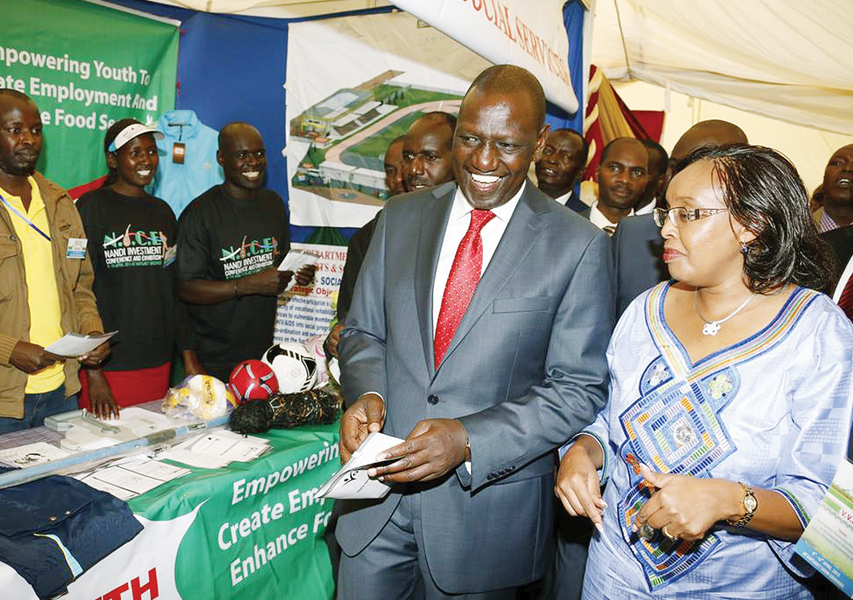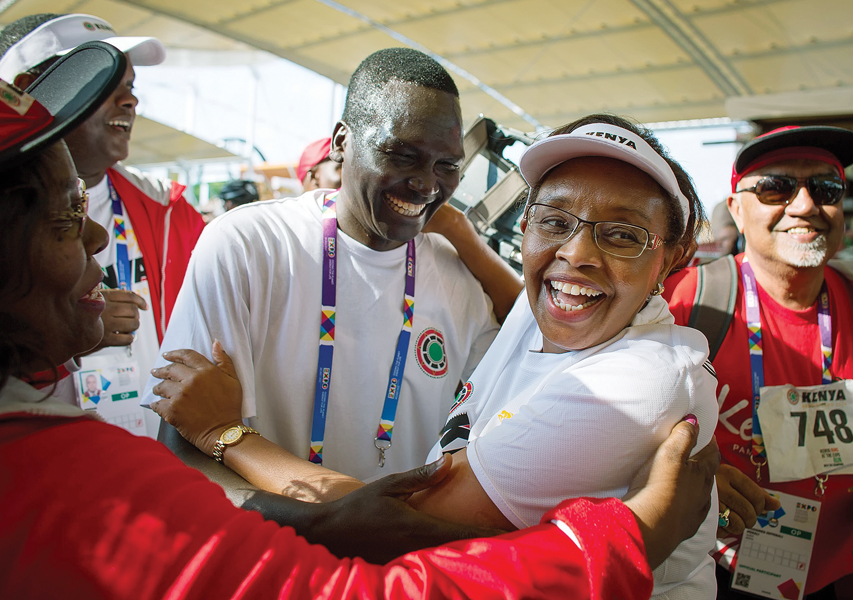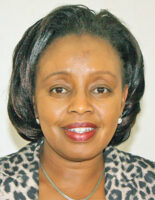
Shy and timid. These two words loudly greeted and nearly scuttled Phyllis Kandie’s entry into the Cabinet. And a member of Parliament even invented a moniker — “shyometer”— on the floor of the august House as members heatedly debated her suitability to head the Ministry of East African Affairs, Commerce and Tourism in President Uhuru Kenyatta’s inaugural Cabinet.
Kandie missed Parliament’s disapproval by a whisker. That she was almost “returned to sender” made her debut in the Cabinet markedly wobbly.
When she appeared before the parliamentary committee to be vetted for the post, she appeared ill at ease, fretting, and even faltering in her speech as she answered questions. Her performance at the interview in the full glare of television cameras so split the committee’s opinion that the chairman tabled a non-unanimous decision to reject her appointment as its own members openly differed in Parliament.
A section of the committee felt that of the 16 names the President had submitted to Parliament for vetting, only Kandie did not fit the bill, hence sparking protracted debate in the House. As some MPs argued that her shyness and self-effacing countenance did not reflect her competence, Gem MP Jakoyo Midiwo wondered aloud what “shyometer” was being used to measure the degree of her shyness. Some members argued that Kandie’s timid demeanour did not match her impressive CV.
She later attributed her poor showing at the vetting to “one minute of self-doubt” when the MPs asked her questions she was uncomfortable with.
Once President Uhuru Kenyatta and his deputy, William Ruto, were sworn into office in April 2013, their next daunting task was to craft a Cabinet and the necessary administrative structures to govern the country and deliver on their key campaign promises. As the first President and Deputy President to be elected under the (then new) Constitution 2010, the full implementation of the charter fell squarely on their shoulders.
The task was made even more interesting by the requirements in Article 152 that changed the name “minister” to “Cabinet secretary” (CS), and dictated that CSs hold no other public office. Kenyans largely interpreted this to mean that the Cabinet would consist of purely professional men and women devoid of political affiliations.
Indeed, in one of the press briefings at State House, Nairobi, before the Cabinet line-up was released, Ruto said: “Kenyans said they do not want a Cabinet of politicians and that is what we are working on. Our Cabinet will be a Cabinet of professionals who will steer the development agenda of this country.”
It was in that context of uncharted constitutional waters amid great public expectation that Kenyatta and Ruto, dubbed “the dynamic duo’’ because of their exuberant camaraderie, stepped into the presidency. Kenyans were eagerly waiting for the President’s first Cabinet appointments.
And so, when he, accompanied by his deputy, stepped out to read the list of nominees on April 24, 2013, the President’s inaugural Cabinet sprang quite a few surprises. Not only did the manner of presentation shock the country, some of the names and faces that were unveiled as the key drivers of the Jubilee administration’s agenda came as a surprise.
The first batch of 16 nominees out of the maximum 22 consisted of hitherto virtually unknown individuals picked from the government and the private sector. Upon introducing them (they were unveiled one by one, like star actors of premier film on stage) President Kenyatta summed it up thus: “We are giving Kenyans the best brains that will enable us deliver our Jubilee manifesto and uplift the wellbeing of the nation.”
And one of those “best brains” was little-known Phyllis Jepkosgei Kipingor-Kandie, who was plucked from Crescent Standard Investment Bank, where she worked as a director. The President nominated her to be the Cabinet Secretary for East African Affairs, Commerce and Tourism. She would be charged with the development of cogent trade and tourism policies, as stated in the Jubilee party manifesto.
Her surprise appointment sent ripples of excitement across her home village of Poror in Eldama Ravine, Baringo County. Many of them had never seen the fresh nominee who describes herself as an investment banker. Most local residents only know her father, Elkana Kipingor, who, until his death in January 2022 aged 94, was a prominent farmer in the area.

With the nascent Jubilee administration being a coalition of Kenyatta’s The National Alliance party (TNA) and Ruto’s United Republican Party (URP), it was expected that the list would comprise nominees fronted by both parties. The two leaders were expected to consult each other and propose names for ministerial and other high-level government appointments.
As such, analysts believe Kandie was appointed through the Ruto wing of the coalition. Her appointment, like those of her female colleagues, was also seen as a plus in the fight for the elusive gender parity in public service.
But it was hard to discern whether there was political rhyme or reason behind her choice given that the banker led a rather private life and pursued much of her studies abroad. Kandie had hardly been seen or known to engage in any political or quasi-political activities in her home county.
Her bachelor’s degree in commerce, majoring in economics from St Mary’s University, Canada, as well as two post-graduate degrees (Master of Arts, Middlesex University, and MBA Finance, Durham University, United Kingdom) coupled with her experience in the financial investment sector may have primed Kandie as the woman the president needed for the Trade and Tourism dockets.
She has also worked in the Capital Markets Authority (CMA) and the Kenya Revenue Authority (KRA).
Kandie once told a breakfast show interview on KTN in 2015 that the appointment to lead the expanded ministry made her a bit jittery as she was not used to the limelight that comes with such a high-profile public office. “I came from the private sector and, you know, private sector people are private… taking a big step like being in charge of a public office is not easy for everybody,” she said.
“However,” she added, “I learnt quickly on the job, got the team together and we are working very well.”
And there was no time to stand and stare for the then 48-year-old mother of two who had been an investment honcho in various organisations. Her in-tray was overflowing with urgent matters to be attended to in the Tourism docket, which had taken severe hits from sporadic terrorist attacks.
Incidents of Al Shabaab militants from Somalia targeting tourist hotels with explosives and abducting guests at the Coast had been on the rise since 2010. This had prompted the government to send Kenya Defence Forces (KDF) soldiers into Somalia in 2011 to fight the Al Qaeda-affiliated terrorists in their bases.
“We are in the process of executing a major recovery programme that is geared towards turning around the image and perception of Kenya among potential visitors,” she told the Oxford Business Group, adding that it was regrettable that as of December 2013, tourism numbers had fallen by 15 per cent due to negative publicity and the resultant travel advisories in key source markets.
Barely four months into her tenure, Kenya experienced one of the worst terrorist attacks that shook the country’s tourism sector. In the mid-morning of September 13, 2013, armed terrorists walked into the Westgate Mall in Westlands, Nairobi, shooting at people indiscriminately and taking others hostage. By the end of the siege that lasted three days, the terrorists had killed more than 60 people, injured scores of others, and destroyed part of the building.
The tourism sector was hurting, Kandie told Citizen TV’s Julie Gichuru on Sunday Live in 2014, that tourism was suffering, not only because of the numerous terrorism attacks in Nairobi after the Westgate assault the previous year, but also from the travel advisories issued by the leading tourist source countries. She had to craft a strategy to counter the negative publicity locally and abroad, and reassure markets on the security measures the government was taking to contain the menace.
Despite her false start, it did not take Kandie and her team, which included Principal secretaries Susan Mochache and Dr Ibrahim Mohammed, long to find her groove in the expanded ministry. Soon she was airborne, leading delegations to numerous capitals to market the country’s tourism, trade, and investment opportunities to potential international travellers and investors. Initially sceptical Kenyans were now seeing a suave and eloquent Kandie consummately articulating government policies and programmes in her docket to local and international audiences.
“I would like to assure you that the government of Kenya takes security very, very seriously and is committed to ensure that it gives security not only to its own citizens but to its visitors and investors as well,” she told a Hellenic-Kenyan Business and Investment Forum in Athens, Greece, in late 2013. She reiterated that terrorism was a global threat, not just a Kenyan issue, and that what happened at the Westgate Mall in Nairobi could happen anywhere else in the world.
Noting that Kenya and Greece enjoyed good trading relations, Kandie, a one-time consultant with the World Bank, said trade exchanges between the two countries rose from $8.83 million in 2008 to $11.88 million in 2011. However, the global economic crisis of 2012 saw it drop to $8.72 million. Tapping into Greece’s ancient history to woo its investors and citizens to Kenya, Kandie assured them that Kenya was an avid consumer of the great historical gifts that their country offers the world such as philosophy, democracy, the Olympics, and the Marathon. She urged them to make Kenya a preferred destination for Greek investment and source of imports.
Married to Ambassador Julius Kandie, a career diplomat and former Solicitor General, and considering the nature of her ministry, Kandie was no doubt a widely-travelled person. Her academic and professional journey of thousands of kilometres around the world began with baby steps in her village in Eldama Ravine, Baringo County, where she attended Poror Primary School before going to Kapropita Girl’s High school for her ‘O’ level studies.
In picking her for his Cabinet, President Kenyatta must have hoped to tap her global exposure and charming demeanour to project the country’s image to the world and advance the government’s trade and tourism targets.
Conversations with officials who worked with the CS said because of her background in financial training and extensive experience as a consultant she clearly understood issues of trade.
“She was up to the task of regional trade, non-tariff barriers. She was also the spouse of an ambassador who had done stints in the UK and Austria and would be best placed to attract tourists,” said a senior adviser who worked with her.
He added that from the word go Kandie hit the ground running and was passionate about the job. “Having not worked in government before, she was a keen learner. She often consulted with heads of departments and advisers, asking them to break down issues for her,” the adviser said.
Then, in late November 2015, President Kenyatta reshuffled the Cabinet after the exit of several CSs implicated in corruption in a dossier that the Head of State had presented to Parliament earlier that week. The reshuffle saw Kandie’s ministry reorganised to become East African Community, Labour and Social Protection. The tourism docket was removed.
And here she found herself facing the challenge of delivering one of the government’s key policies on social protection. Under the social protection programme, the CS said, the government had instituted three avenues to help vulnerable groups of its citizens such as orphans, the elderly, and persons with disability.
These channels were social assistance, a cash transfer programme dubbed “Inua Jamii,” managed by the Ministry of Labour; health insurance offered by the Ministry of Health under the National Health Insurance Fund (NHIF); and the social security programme run by the National Social Security Fund (NSSF).
She went around the country to oversee the recruitment of senior citizens (those over 70 years of age) and ensure that the disbursements were seamless and on time.
Kandie was also keen on the condition of Kenyans abroad, visiting the United Arab Emirates, Kuwait, and Saudi Arabia to talk to their officials and Kenyan embassies in efforts to ensure that Kenyans’ complaints were addressed expeditiously.
In a media interview, Kandie explained that since Jubilee came to power in 2013, 50,000 households had been brought under the social assistance programme. The new government, she said, had committed itself to reach out to one million households and make them beneficiaries of the programme by the end of its first term of office in 2017. Although the target was high, the CS was upbeat that, working with other partners such the World Bank and the (UK) Department for International Development (DFID), they had achieved about 70 per cent of the target by September 2016.
The CS said she had instituted various reforms to improve the ministry’s processes. Among the changes was the single registry plan that aimed to bring together all the social protection programmes under one roof. Initially, she said, the three activities (social assistance, health insurance, and social security) ran parallel to one another.
“We are transforming the programme to consolidate the activities in one ministry so that all information about it is easily available to Kenyans,” she said.
Despite her checkered success, however, it is apparent that the experiment with purely technocratic Cabinet secretaries faced such a severe test that President Kenyatta dropped some non-politician ministers while forming his new government after the 2017 elections. Kandie was one of them.
However, in January 2018, she was sent to Brussels as Kenya’s ambassador to Belgium, Luxembourg, and the European Union, a posting she must be at ease with considering its nature as an away-from-the-limelight assignment, her extensive international travel, and rich education in investment and commerce.
